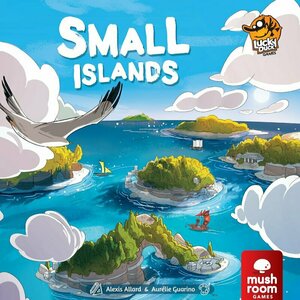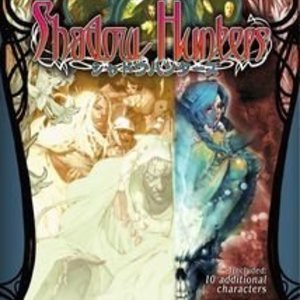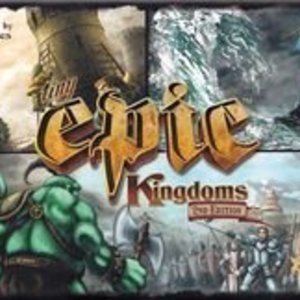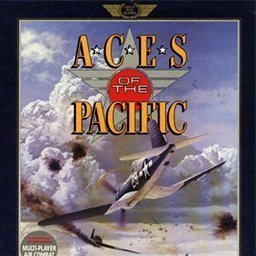
Aces of the Pacific
Video Game Watch
Aces of the Pacific features various warplanes of the era, such as the F6F Hellcat and the Zero. The...
Purple Phoenix Games (2266 KP) rated Small Islands in Tabletop Games
Oct 13, 2021
Small Islands is a tile placement exploration game for one to four players. In it, players are explorers tasked with discovering resource-rich new islands upon which their clans may either exploit or inhabit. However, it’s each clan for themselves, and the players all need those precious resources. In the solo game, the player’s AI opponent is Alexis Allard, designer of the game. He has goal cards to be used and finishing point totals that the solo player will be attempting to beat during the course of the game.
DISCLAIMER: We were provided a copy of this game for the purposes of this review. This is a retail copy of the game, so what you see in these photos is exactly what would be received in your box. I do not intend to cover every single rule included in the rulebook, but will describe the overall game flow and major rule set so that our readers may get a sense of how the game plays. For more in depth rules, you may purchase a copy online or from your FLGS. -T
To setup, the player claims their player color and assigns Alexis with his color. They take all the components for each player and places them on the table. The starting tiles (that feature flying seagulls) are placed on the table in any orientation that is legal for play: islands need to connect, and seas need to flow from one tile to the next, as seen below. The Landscape tiles are to be shuffled and placed within reach. The four ship tiles are displayed, with all ships on their gray side, save for the solo player’s chosen color. The Navigation tile is placed below the ship tiles, and the beginning three Landscape tiles are placed in a row beside it. The small stack of Objective cards are shuffled and placed nearby, with the player drawing one to begin. They also draw two Landscape to start. For solo play, one Alexis difficulty card is chosen, and his deck of Explore and Land cards is built accordingly. The Prestige (VP) tokens are (apparently when I play) just thrown on the table and gathered in a loose pile. The game may now begin!
Small Islands is played over four rounds, with several turns being played per round. The solo player begins each round with their turn. A turn is divided into three phases: Preparation, Exploration, Reward. The Preparation phase has the player populating the Navigation Tile with six Landscape tiles face-down as a draw stack. The player then draws two Objective cards to add to their one they are currently holding. From these three cards the player will choose one to become their current objective for the round, one to be saved for a future round, and one to be discarded back to the stack. These Objective cards provide a strategy to guide the player through the current round, and also setup future rounds for scoring purposes. Upon them are icons that will award the player with points for scoring islands containing specific combinations of resources.
During the Exploration phase in the solo game, the player takes their turn first, and then Alexis will take his. A typical Exploration phase has a player deciding if they will Explore a tile or Land a ship. To Explore a tile, the player chooses one of the face-up Landscape tiles from the market/offer row and, along with their two held tiles, choose one to add to the play area. These tiles may be rotated in any fashion, as long as they can be legally placed: island edges are to be extended, sea spaces connected, et al. It is also at this time the player may place one of their Bonus Tokens upon any tile on the play area. These Bonus Tokens are resource icons that cover up existing icons on a tile, or directly over another Bonus Token. A player would do this in order to affect the balance of icons on a given island for scoring purposes.
Should the Navigation tile be empty of Landscape tiles and the player wish, they may instead Land a ship, thus ending the Exploration phase. The player chooses any of the ship tiles, and places it legally on the play area (in a sea space, as shown below). Once the player ends the phase, the game progresses to the Reward phase.
After the player takes their turn during the Exploration phase, Alexis takes his turn. This is done by drawing an Expedition card from his stack and following its instructions. The Expedition card will show whether Alexis would like to Explore or Land, which Landscape tile he would like to draw, and where he would like to place it – in relation to where the last player tile was placed.
During the Reward phase, the player will place any of their clan houseeples they wish on any island upon which they have not placed a houseeple previously. Then, consulting their Objective card, score points for successfully satisfying the card’s requirements. For Alexis, the player will draw a new Expedition card from Alexis’s stack, note the icons present on the Mission area of the card, and place Alexis houseeples upon islands that satisfy its requirements.
The game continues in this fashion until the fourth round is complete. The player totals their Prestige points (VP) and if they score more than Alexis, they win! The player must then take a picture of their archipelago they built and send it to the designer directly and gloat to them about their massive victory. Or simply rest in the satisfaction of having played the game well. Whichever.
Components. This game has a lot of components, and they are mostly cardboard and houseeples. The cardstock and board are good quality, as I have come to expect from Lucky Duck Games, and the houseeples are all different shapes for each clan color. I find that a nice and unnecessary, but very cool, touch. The art in this one is simply amazing. I mean, look at these photos! Everything from the color scheme to the art style all mesh well and give a well-considered polish to a great theme.
Okay, I won’t even hide it – I LOOOOOOVE this game. I never really liked Carcassonne very much, but Small Islands gives a similar feel, but executes everything so much better. Even with the solo rules. There are so many options available at any one time, and having a random Alexis game each time you play is just so satisfying. I feel like I could keep this game forever and not play the same game twice. Ever. And I think that I would WANT to play this one forever. Yes, I think this is a solid fit for my collection indeed, and I can see it working for so many different gamer types.
Having Alexis constantly applying the pressure to maximize and strategize every turn is delicious, and having almost zero conflict with him as we both explore is welcome. You know when you start the game how many points Alexis will score at the end of the game, so having that knowledge really makes you consider all the options available. It just works on so many levels.
If you are looking for a light-hearted, but with some great decisions to be made, then I strongly urge you to check out Small Islands. I knew immediately that this was a game for me. It’s on the lighter side without being too simple, I get to build a thing and admire it at the end of the game, and I have an opponent who just wants to see me win because he designed the game! I’m in and out in less than an hour and feel content that I was able to have a great experience with a well-designed game. I cannot wait to introduce this to all my friends and family gamers so they can fall in love with it as well.
Purple Phoenix Games (2266 KP) rated Shadow Hunters in Tabletop Games
Jul 24, 2021
Shadow Hunters is a hidden identity survival card game for groups of 4-8 players. Each player’s drawn persona will belong to the Shadows, the Hunters, or Neutrals (common bystanders). The goals of the players may all be completely different and the game may end at any time due to fulfilling personal agendas. Players may even win when their characters are dead!
To setup place the board on the table and randomly populate the card spaces on the board with the Area Cards. Shuffle the White Cards, Black Cards, and Hermit Cards (why didn’t they just name these the Green Cards?) into their own stacks and place them on the side of the board in their slots. Players choose their preferred colors, take the boards and pieces with that color, and place one of their wooden markers on the No Damage space on the board. The other wooden marker will be used for movement on the board Area cards. Shuffle and deal each player one Character Card to be kept secret from the other players. Determine start player and the game is ready to begin!
On a player’s turn they will be completing at least one task and then possible other tasks. First, the active player will roll both the 1d6 and 1d4 together to arrive at a number between two and 10. The player will place their marker on the matching Area card on the board. Should a player roll a seven they may choose any location other than the space they are on and move. Each location will have an action printed on its card that a player may choose to complete. These could be drawing cards from the White, Black, or Hermit decks, damaging other players, or stealing equipment cards from them. Lastly, the active player may straight up attack another player within the same Area range (the three different areas are two cards linked together, so either the card the marker shares or the one that is linked).
As soon as a character has suffered damage equal to or greater than the HP shown on their Character Card, that character dies. Once a character dies, the owning player flips the Character Card over to reveal the character and, more importantly, their faction to which they belong. If this causes one player to fulfill their character’s goals, they must announce that the game is over. If not, play continues in this fashion until a player’s goal has been achieved to end the game. This could mean the Shadow team or Hunter team wins as a group, or that one player wins alone.
Components. Oddly, this edition of Shadow Hunters is now almost 10 years old, so it fall within the “older games” group. That said, the components are still excellent quality, even by today’s standards. The cards have a faint linen finish, the cardboard components are all thick and matte finished, the wooden player markers are chunky and fun to move around. The only issues I have with components are that I wish the colors matched more on the wooden markers and the player boards. Not a huge deal, but something that makes me cringe just a little inside. The other issue I have is most definitely a personal preference: the numbers on the d4 are on the bottom and I prefer them on the top. I know, purely personal preference and I’m dumb for even mentioning it.
This is a game I love but irks my wife. And not even because she doesn’t like the game. It irks her because of how I play it. Until I use the Hermit Cards to try to help figure out which player is on my team I will certainly be attacking everyone I can every chance I get. That’s not the best way to make friends, and I get it, but I’m not taking that chance of allowing a potential opponent to get a leg up on me. That bothers my wife because many times I’m attacking my teammates. Oh well.
I have played this game so many times with different groups and have had great success with it almost every single time. It’s an easy teach, the theme makes sense, and having different end goals is something that many people can rally behind. I know there are about 3,000 hidden identity games out there, but I consider this one of the best. Even 10 years later it sill holds that sheen and gives us a little different experience than just spamming The Resistance: Avalon every time. Purple Phoenix Games gives this one a hot 17 / 24. Pick this one up if you find it in the wild and want a different feel for your hidden identity collection. I love it and you might too.
Purple Phoenix Games (2266 KP) rated Tiny Epic Kingdoms in Tabletop Games
Jul 30, 2019
In Tiny Epic Kingdoms, you are the ruler of (you guessed it) a tiny kingdom. You, however, are not content with simply maintaining your realm – you have plans to expand your borders and make your kingdom not-so-tiny! Send your adventurers out to explore new lands, learn new magics, construct towers to assert your dominance, and fight off others who would stand in your way! Do you have the strategy necessary to outwit your competitors and grow your kingdom? Play to find out!
DISCLAIMER: There are several expansions to this game, but we are not reviewing them at this time. Should we review them in the future we will either update this review or post a link to the new material here. -T
Tiny Epic Kingdoms is a game of worker placement, area control, and action point allowance. Players take turns gathering resources, buildings towers, researching magic, or exploring (and potentially waging war) in new lands. As the active player, on your turn you will select and perform one of the six available actions from the Action Card: Patrol, Quest, Build, Research, Expand, or Trade. Following your action, and still on your turn, the remaining players will either decide to perform the same action you chose, or collect resources. Once everyone has had the chance to act, your turn is over. The next player now becomes the active player and the process repeats with one big change – the action you chose on your turn is no longer available for selection. Each subsequent active player will always have 1 fewer action choice on their turn. This process repeats until there are no more actions available. When this happens, the Action Card is cleared and all actions are available once more for selection. Strategy is key – which action can you choose on your turn to best benefit you while also inhibiting your competitors? The game ends at the end of the turn in which one of these three things has happened: a player has all of their meeples in play, a player has built the 6th level on the tower card, or a player has reached the 5th level of magic on their faction card. End-game points are scored based on meeples in play, magic level, tower level, and control of Capital Cities. The player with the highest score wins!
For such a small game, there’s definitely a fair amount of strategy involved in Tiny Epic Kingdoms. You’ve got to decide on the best approach for you, and it must be adaptable to any given situation. Do you play it safe, quietly collecting resources, trying to achieve your end-game goals the fastest? Or do you venture out to confront your opponents, trying to usurp their territory and resources and take them out as your competition? Or maybe you try to stay civil, but an opponent is threatening your progress and now you’ve got to fight back? There are lots of strategic options, and every game feels like a new challenge.
One thing I enjoy about Tiny Epic Kingdoms is that you get to act on every single turn, even if you aren’t the active player. You don’t have to sit there and watch your friends play – you have the chance to benefit during every single turn, even if it’s merely collecting resources. The opportunity to act on every turn also adds a little bit of ‘take that’ to this game. I might choose an action on my turn as the active player that I know one of my competitors cannot perform – thus forcing them to collect resources and waste the opportunity to perform that specific action for an entire round. And since that action cannot be picked again until all available actions have already been chosen, I’ve successfully blocked their progress in a certain area of play. Your strategy has to extend beyond just your turn as the active player – you must consider all options for your opponents as well.
The thing I don’t necessarily like about Tiny Epic Kingdoms is that the gameplay can be a little stale. Unless you’re playing with people who actively try to engage with you, it is extremely easy to just stay in your own realm and not even interact with anyone at all. There’s no forced interaction in this game, and although it is admittedly nice sometimes, mostly it just feels like we’re all playing the same game alone. It’s like we all just take turns performing/following actions until someone has triggered the end-game.
Overall, I like Tiny Epic Kingdoms. It’s not my favorite Tiny Epic game, but it’s a good one. There’s a decent amount of strategy involved, but at times it can feel more like a ‘take that’ type game to me. The lack of forced player interaction can lead to dull gameplay and a lackluster experience. It’s not a bad game. It’s just not the most epic Tiny Epic game out there, in my opinion. That’s why Purple Phoenix Games gives it a regal 14 / 18.
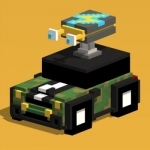
Smashy Road: Arena
Games and Entertainment
App
SMASHY ROAD: ARENA (Single & Multiplayer) From the makers of the Award winning game: Smashy Road:...
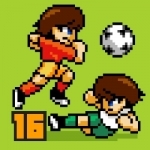
Pixel Cup Soccer 16
Games
App
Pixel Cup Soccer 16 is a casual retro style soccer game, a great evolution from the first edition....
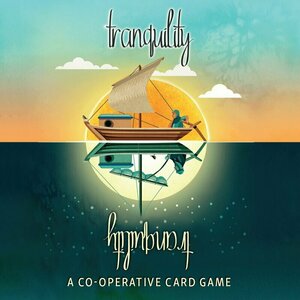
Tranquility
Tabletop Game
Jump on board the good ship Tranquility and set sail for paradise. Take care, though, because in a...
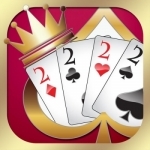
B-Bro Big2 (Pusoy Dos/Capsa/Big Deuce)
Games and Entertainment
App
The Most Complete and Authentic Big 2/Pusoy Dos ! (Chinese Poker,Capsa,Choh Dai Di, Da Lao Er)...

Drakenlords: CCG Card Duels
Games, Entertainment and Stickers
App
Welcome to one of the best CCG games on mobile! Drakenlords is a multiplayer fantasy card game where...

Cricket Captain 2015
Games and Sports
App
As the Australians arrive on the shores of England ahead of the 2015 series, Cricket Captain is...
